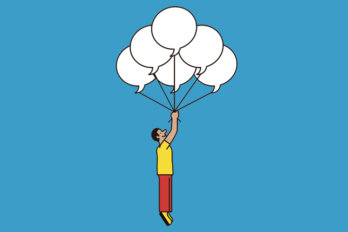Listen to an audio version of this story
For more audio from The Walrus, subscribe to AMI-audio podcasts on iTunes.
There’s something to be said for the Blockbuster video store of my youth. It was what we had in the suburbs, and it suited the way my mind worked. I liked encountering movies as physical objects dispersed throughout a large room, arranged down walls (where the new releases went) and along shelves (where the older stuff tarried). I suspect the image of walking through such a room will one day amuse my children, four and two.
Still, I miss browsing those chunky, foxed VHS cases and, I suppose, their leaner DVD heirs. You could wander and let your eyes fall where they fell. The supply of any given video was finite, which meant you sometimes had to figure out a Plan B. You had to swivel, double back, hunker down, tilt your head. You could be aimless in a Wordsworthian way. You could meander. This aisle, maybe, or that one. Couples paralyzed by indecision stood around like Vladimirs and Estragons.
The aisles of the Blockbuster were themed, though less aggressively, less knowingly than the rows that march relentlessly down the Netflix home page. A particular shelf didn’t remember if you had selected one of its videos before and thus didn’t try to push a similar title at you. The real-world tiles didn’t proactively rearrange themselves in anticipation of your unique wants. In lieu of tailored algorithms, there were a few shelves given over to staff recommendations. These challenged you to ignore the new-release walls, decorated by market forces, and defer to the taste of an authority (or, at least, a part-time employee majoring in film).
It was a Blockbuster shelf that showed me a copy of The Third Man, the fiftieth anniversary edition on VHS. The tape came sleeved in a beguiling black-and-white cover, irising around the image of Orson Welles. I hadn’t been looking for The Third Man—I barely knew what it was—but I’d been eyeing that cover for some time. Or had Welles been eyeing me? I took the tape home, finally, and played it.
I adored The Third Man. In time, I sought out Citizen Kane, Welles’s most famous picture. The DVD came with two audio commentary tracks, one by filmmaker Peter Bogdanovich, a protégé of Welles’s. Bogdanovich’s weary, deep voice, speaking slowly over Kane, transfixed me. It seemed to dredge, almost reluctantly, a deep and singular store of insights and anecdotes. It was a kind of antipodcast, pocked with sighs and silences. It was enormously attractive. I sought out other Welles films but also other DVDs that carried Bogdanovich’s commentaries: The Searchers, Bringing Up Baby, and To Catch a Thief. For a time, I didn’t watch movies so much as listen to Bogdanovich opine on the glories of the golden age of cinema. It was, I realized later, a rogue education.
My friends and I made pilgrimages to downtown Toronto, to bigger stores, like Sam the Record Man and HMV, and smaller concerns, like Vintage Video. There were hesitations, flirtations. I passed on a VHS copy of David Lynch’s Wild at Heart and then changed my mind only to find it had wriggled out of the HMV and, worse, out of print. Vintage Video, for its part, stocked rare and out-of-print movies at hefty prices. Half the time—maybe most of the time—you couldn’t secure what you were looking for; the gruff, likable owner seemed to exist to assure you that the precious item you sought was long gone. Still, I walked out of there with finds that weren’t, back then, easily findable: Eraserhead, Chimes at Midnight, Cockfighter. One day, my friend Mitch turned up The Night of the Hunter; Stephen King’s book about the history of horror, Danse Macabre, had sent Mitch on his own private quest for culture. It was, as the kids no longer say, good times.
Those locations of Sam the Record Man and HMV are gone now, of course. A lone Sam persists at a mall in Belleville, Ontario. You can buy a T-shirt there that says, “Yes, this is the last Sam the Record Man.” Vintage Video was uprooted by developers. It doesn’t seem to have taken in its new location, which Google Street View reveals is now a Wine Rack.
Perhaps Netflix and other streaming services are sending young, twenty-first-century minds rafting down tributaries of their own. I would love to imagine an algorithm steering these minds from an interest in the latest Wes Anderson product to a curiosity about Peter Bogdanovich’s obscure, proto-Andersonian screwball delight They All Laughed and then on toward a taste for greater vistas, like Jean Renoir’s The Rules of the Game.
But speed of scrolling, algorithmic assistance, and instant access weren’t what my friends and I needed, even if we might’ve welcomed them as conveniences. We needed that long subway trip downtown. (We were the farthest stop west.) We needed the sobering disappointments and sporadic victories. We needed the longueurs that new technology seeks to close, as if abolishing boredom ever does anyone a favour. Mostly, we needed wind resistance. It took effort to cultivate our enthusiasms in a desert, but it’s clear now that we took the desert’s role for granted. Knowledge tends to stick when you’ve toiled for it.
“Information moves, or we move to it,” wrote sci-fi novelist Neal Stephenson in Wired magazine back in the ’90s. “Moving to it has rarely been popular and is growing unfashionable; nowadays we demand that the information come to us.”
How hoary the old pathways look to us now, like ruts left by a stagecoach. What elaborate workarounds and wastes of time we’d evolved to find the content that now floods our phones. The sheer legwork of it all! One of my rituals, when I was downtown, was to steal into the so-called World’s Biggest Bookstore (since razed for condos) and head for Music or Performing Arts or whatever the section was called. There, I’d browse the shelves for record guides to determine which albums might be worth my time (though clearly I had lots of time). Leafing through the goods was frowned upon. But there was always a well-thumbed copy of a guide that looked too battered for anyone to want; yet, like an oracle, it had entertained visitors. Anyway, I would eventually cross the street to HMV or Sam the Record Man and buy the album I’d settled on.
Scrolling has rendered this entire process—an afternoon’s worth of activity—obsolete. Who needs all that tramping around cumbersome cities with boon companions? In a matter of clicks, armed mainly with a thumb, you can call up a consumer report, make your decision, and then head over to Amazon to seal the deal. You have your afternoon back. Not that you’d fill it with quiet reverie, of course: the new efficiencies merely make room for yet more scrolling.
The pandemic lockdown shuttered many storefronts and surely reduced many holdout browsers to scrollers; there was no other way to acquire certain things. (I was especially gutted to see Soundscapes, Toronto’s finest record store, close shop while this very essay was in production.) But the Age of Scrolling had already long ago nudged the Age of Browsing off screen.
You could watch the catastrophe in real time, like a glacier calving. I started an undergraduate degree in 1997 and, in no particular hurry, emerged, nearly a decade and a half later, into a different world, with a doctorate in English. In the early days—when few of us possessed laptops and social media had yet to metastasize—I loved getting lost in the library stacks. I whiled away breaks between classes by stumbling on books that had nothing to do with my assignments. Within a decade, though, the library’s patrons were conspicuously immobile: they sat along walls and in alcoves, laptops open on their laps, serenely siloed against the press of books all around. It was almost creepy. If the essay they were writing called for a quote, they could call up a PDF from an electronic journal. No physical labour required—just a cursory search, a cut and paste. The students had become scrollers, and the indifference of so many of them to the very stacks I used to haunt was heartbreaking.
When I came to have my own students, I rooted out the plagiarists merely by noticing competing quotation styles—curly and straight—in the same essay. Straight double quotation marks were a clue that text had been copied from another source, converted to plain text, and pasted in. Whenever I saw a mix of curly and straight double quotation marks, I started googling passages outside of the quotation marks—and sometimes found that the student had smuggled in unattributed text. It was forensic crime-lab copy-editing. My scrolling had uncovered theirs.
But many of the nonplagiarists had clearly pasted in passages too. (They were honest; they’d merely failed to clean up the straight quotation marks.) Such passages were the kind that I would’ve retyped manually, from books spread open with an awkward elbow or paperweighted some other way. Passages I came by honestly, passages I felt I’d come to possess. Indeed, it was a three-hour journey, round trip, to bring them home to my computer. I lived far from the university.
Back then, I hadn’t worked out a high-minded, romantic philosophy about the virtues of wrangling physical media. (And, later, as a tired PhD candidate trying to complete a dissertation, I saw the appeal of summoning digitized articles with a couple of keystrokes.) But, as a restless younger student—still trying to pinpoint his interests and shed the suburbs—the journey to the stacks was no bother. Really. I was happy to travel hours for a book. The book gave me something to read on the way home.
Let’s be clear: I’m not immune to the pleasures of a smartphone or the convenience of streaming. And I’m not suggesting some better way to navigate information on a screen. I assume Zuckerberg et al. have sorted the screens out. That is, I assume that scrolling, by way of flicks of finger, is the best option we have until our smartphones leap the divide, pass through our pupils, and take up in our brains.
But the internet is as riven, in its way, as the scraps of ancient papyrus museums display—you just can’t see the lacunae. Many albums and movies can’t be streamed and lie stranded in physical formats, in the tar pit of the past. Hyperlinks to pieces I wrote only a few years ago have already rotted like rope bridges.
So I buy books from brick-and-mortar shops when I can. And CDs and DVDs too, though the stores that stock those have dwindled. Mostly, I try to slow down, which, really, was the benefit of old-school browsing in the first place. Browsing couldn’t be done with the flick of a thumb. It plunged you into your entire body and set the body afoot, sometimes for hours, with no smartphone to check—and no easy way for others to check in. Browsing forced you to reckon with physical media, to wander among aisles and stacks that didn’t presume to know your preferences and weren’t so insidiously jostling for your attention. You could pause, eye a spine, and tip some strange compact sliver of the world toward you. Only the mildest of inputs—the background noise of the store, say, or the muffled car horns of the street—competed for your interest. You were exquisitely alone.
I don’t offer a program of resistance except to say: when culture is a literal click away, you should want to slow down and conjure some hurdles, make consumption a gradation harder. Cut down on your web-based content, maybe. Balk at the bingeable. Use the internet, if you must, but as a delivery system. (Go ahead and buy those expensive Criterion DVDs.) Revel in what arrives in the good old mail and spurn what comes too easily. Seek out first editions, rare albums, out-of-print movies, old numbers of magazines someone took the care to shrink-wrap. When not in lockdown owing to a global pandemic, visit bookstores and record shops, and often. Arrange to forget your smartphone and contrive to be alone. You will be amazed at what lies just out of view of the scroll.




